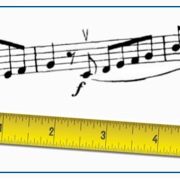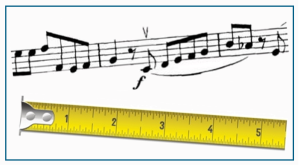Numbers Versus Images
Our brains like numbers. Whether we engage in scientific, artistic, sporting or other activities, we focus on aspects that can be measured–meaning assigned a numerical value. These quantifiable aspects allow us to make objective assessments of our performances (in music or in other fields) and, in turn, compare our performances to those of others. Our music development is subject to quantifiable aspects as well, making us focus on “numeric” goals: we want to play faster, or louder, practice more hours, miss fewer notes, play more pieces.
These parameters are, of course, isolated aspects of music-making. They do not mean anything in themselves. Think of the performer who can play fast, loudly and accurately, and yet does not really “make music.” What we ultimately value most are rather immeasurable concepts, such as the expressiveness of a performance, its eloquence, clarity or coherence, the atmospheres it creates, its stylistic adherence, and others. Also, consider all of the character words in movement indications: Allegro spiritoso, Adagio cantabile, etc. How can we measure a spiritoso or a cantabile?
It might be revealing to think of these immeasurable concepts as the combination of many quantifiable parameters working together. In other words, when we work on a parameter (speed, dynamic, timbre) we are only covering one aspect of the many that constitute a performance. Therefore, this dissecting, although quite necessary in our technique practice sessions, is inherently incomplete at an interpretative level. Obvious as this might sound, it is often overlooked in lessons.
It is easy to refer to isolated parameters when teaching, since they offer immediate solutions by making students to focus on one specific task. However, this approach hardly teaches our students anything truly valuable, and can occasionally mislead them. And there are many instances where we resort to these parameters, since they are many and inconspicuous. Seemingly immeasurable elements, such as the vibrato on a note, or an accelerando in a passage, are ultimately quantifiable in some sense (we can measure the speed and width of a vibrato, or the gradient of an accelerando). If we instead refer to immeasurable concepts in our lessons, we push our students to consider the resulting effect of multiple parameters instead of focusing only on one. This makes them contemplate the broad picture rather than isolated means, deploying their critical thinking and developing their full artistry. The following examples might illustrate.
Suppose that a student is playing a passage too slowly; the music drags and sounds disconnected. The immediate solution is to indicate that the passage should be faster. Speed is a parameter (we can assign it a metronome value) and next time the student’s focus will be, exclusively, on playing the passage faster. Instead, if we say that the passage drags, or sounds heavy, or needs to flow, or any other imagery we find appropriate, we make our student think on ways to remedy that. The first advantage is that by not offering a quick solution (to play faster), we make the student imagine the goal (a flowing interpretation of such passage) instead of immediately focusing on an isolated element (speed). Yet more importantly, the full solution might not only require playing faster, but also involve other aspects such as the use of rubato, dynamic inflections, agogic accents, and other devices. These are not included in the directive “play faster” and a student would hardly consider them when responding to it.
Another example: if we ask a student to play a passage softer, he or she will do it, resorting to a sort of inner decibel meter in order to calibrate the playing volume. We might know why the passage needs to be softer–perhaps it needs to portray an intimate, introverted character. But the student will hardly think about this; artistry will be set aside and the full attention will turn to playing with less force. If we instead say that the passage needs, for example, to convey intimacy, our student will have to imagine ways to achieve intimacy through sound, and playing softer will come as a natural consequence of understanding the passage’s character. Again, playing softly might be the most noticeable aspect, but is only one of many parameters that need to work together to convey intimacy–soft does not necessarily mean intimate. By thinking about intimacy instead of volume, playing softer will appear in combination with other aspects, such as a warmer tone, rubato, legato, vibrato, etc.
As teachers, our goal is to form independent artists, who someday will no longer need us for interpretative guidance; we should invite their artistry and encourage their critical thinking as often as possible.


